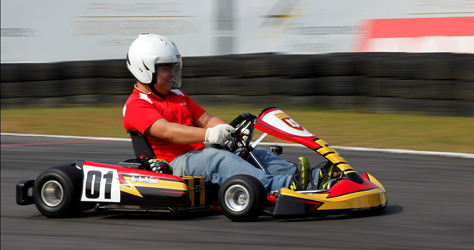Ngee Ann Polytechnic
The Electric Go-Kart is propelled by an electric motor powered by batteries with zero emission resulting in a cleaner and more environmentally-friendly vehicle. Therefore, it incurs less waste compared to its conventional engine-powered counterpart without diminishing the performance of the vehicle or the fun elements of the driving experience.
The electric motor provides higher torque at low speeds so that the Electric Go-Kart can accelerate quickly from starting and during cornering. It is quieter and produces less vibration.
The Electric Go-Kart consists of added safety features such as remote power cut-off and emergency power cut-off.
Electricity Generating Barbeque Pit

The Electricity Generating Barbeque Pit uses an innovative approach by turning waste heat, generated from the BBQ session, into electricity to power devices or appliances.
Thermo-electric generators (TEGs) convert heat to electricity when it is sandwiched between a heat source and a cooling heat “sink”. The temperature difference between the heat source and heat sink creates a potential difference in the TEGs which then generate electricity. In this project, a panel of 66 TEGs is installed at the barbeque pit with one end in contact with the burning charcoal (the heat source), while the other end is in contact with a reservoir of water (the heat sink) in a suitably designed container that maintains a constant temperature with the surroundings.
Domestic Waste Heat Recovery System
The device has the following features:
Being portable and self-contained, it can be easily deployed in any barbeque pit.
It can be used to provide additional power for illumination if used in an open area where public lighting is not accessible.
The Domestic Waste Heat Recovery System is designed to reclaim waste heat generated by an air-conditioner’s compressor, and to utilize it as a source of energy for heating up water.
Air conditioning units work by transferring heat from an interior space to the ambient air through a refrigerant compression and expansion cycle. The heat available for recovery is the heat removed from the space plus the heat generated from the compression process. In this heat recovery system, an additional heat exchanging unit is installed after the compressor to recover the waste heat instead of allowing it to be rejected to the environment. The heat recovered is utilized as a source of energy for heating up water in a domestic hot water tank.
Test runs have shown that:
- The heat recovery system provides sufficient energy to heat 110 litres of water from room temperature to 40oC in an 8-hour operation of the air conditioning unit.
- This translates to a saving in electricity bill of $20 per month or $240 per year through sharing the heat loads with a conventional electric water heater.